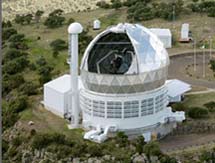
Handy Links
SLAC News Center
SLAC Today
- Subscribe
- Archives: Feb 2006-May 20, 2011
- Archives: May 23, 2011 and later
- Submit Feedback or Story Ideas
- About SLAC Today
SLAC News
Lab News
- Interactions
- Lightsources.org
- ILC NewsLine
- Int'l Science Grid This Week
- Fermilab Today
- Berkeley Lab News
- @brookhaven TODAY
- DOE Pulse
- CERN Courier
- DESY inForm
- US / LHC
SLAC Links
- Emergency
- Safety
- Policy Repository
- Site Entry Form

- Site Maps
- M & O Review
- Computing Status & Calendar
- SLAC Colloquium
- SLACspeak
- SLACspace
- SLAC Logo
- Café Menu
- Flea Market
- Web E-mail
- Marguerite Shuttle
- Discount Commuter Passes
-
Award Reporting Form
- SPIRES
- SciDoc
- Activity Groups
- Library
Stanford
Around the Bay
Science Today: Batch Cosmology
 Traditional optical astronomy, built around
"observing runs,"
takes the team to the mountain for a night or more
of dedicated telescope time. Naturally, observing sites are remote
and these trips are tough on research, teaching and personal schedules.
With most projects granted a handful of nights per year and typical
weather patterns lasting about as long as a run, small number statistics
guarantee that many programs need several years' chances to achieve success.
Some science programs also aren't amenable to block scheduling, as a result of
transient "targets of opportunity" or long-term survey and monitoring programs.
Traditional optical astronomy, built around
"observing runs,"
takes the team to the mountain for a night or more
of dedicated telescope time. Naturally, observing sites are remote
and these trips are tough on research, teaching and personal schedules.
With most projects granted a handful of nights per year and typical
weather patterns lasting about as long as a run, small number statistics
guarantee that many programs need several years' chances to achieve success.
Some science programs also aren't amenable to block scheduling, as a result of
transient "targets of opportunity" or long-term survey and monitoring programs.
For the past ten years, Stanford astronomers have been working with an innovative telescope that addresses some of these needs. The Hobby-Eberly telescope (HET), a joint project of the University of Texas, Penn State University, Stanford and Munich and Goettingen universities in Germany, offers a 9m-class aperture at relatively low cost and a program of dedicated spectroscopic "queue" observing. This means that targets are submitted over the net and ranking codes dynamically select the optimal next target based on science priorities and changing conditions through the night. The data and calibrations are available for download the next morning. Sitting at home, HET partners then analyze and adjust the program on the fly. If the weather does not cooperate, tomorrow is another night, as long as your target is still available.
Two of the largest Stanford programs have strong SLAC/KIPAC connections. One has been targeting bright "blazars," or relativistic jet-dominated quasars that likely form the bulk of the sources detectable by the Gamma-ray Large Area Space Telescope (GLAST). The program has discovered hundreds of new blazars pushing back the redshift frontier to z>5 and laying the groundwork for LAT studies of star and black hole formation in the early universe. A second ongoing program targets Type Ia supernovae detected by the Fall '05-'07 Sloan Digital Sky Survey II project. Catching these transients during outburst has allowed the HET to dramatically increase the number of Ia's at redshifts 0.1 to 0.4, the period where dark energy began to dominate cosmic expansion. This program promises a good step forward in the precision of supernova cosmology and dark energy measurements.
Is anything lost? Some sorts of serendipitous observations are indeed harder to do and 'service' observing sometimes does not take the telescope to the sensitivity limit. But for transient and long term programs, the opportunity to do 'batch' science from campus provides major savings, both in airfare and in wear and tear on the scientists themselves.
óRoger Romani, SLAC Today, January 4, 2007
Above image: The Hobby-Eberly Telescope.